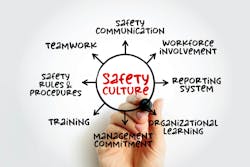Safety Leadership: Making a Culture of Safety the Foundation
Safety is a familiar concept to us all. We read safety reports before we buy a car, instruct our children to wear bicycle helmets and buckle our seat belts in the car. We are surrounded by safety labels on everything from plastic bags to hair dryers. But how often do we talk about safety in our workplace, where we spend one-third of our adult lives?
The answer to this question is not often enough. Data shows that each year an average of 3 million people in private industry face some kind of injury as a result of their jobs. In many industries, injury costs can exceed profit in a given year.
At its core, workplace health and safety has four essential parts:
- Culture - the values, assumptions, norms and everyday behaviors of an organization’s people
- Compliance - meeting mandated regulatory standards
- Risk Management - processes to better identify risk and to control exposures
- Governance - establishing controls by which an organization can validate and ensure compliance standards and policies
To truly create lasting change, organizations must create an environment in which safety is more than just a box to be checked but is an attitude that makes up the very foundation of the company and is upheld by everyone from frontline workers to senior management.
Committing to a Culture of Safety
A culture of safety can be defined as the collective values, beliefs, attitudes and norms that shape individual safety-related behaviors in an organization. Establishing this culture begins with an organization’s senior management. If senior management is committed to improving safety, fostering the success of a safety program and empowering everyone within the organization to be part of a solution, then a culture of safety can flourish. With a culture of safety, everyone looks out for one another and encourages injury self-reporting without judgment or consequence. It’s about improving the culture and system as a whole to find the causal factors that led to those injuries or mistakes.
Analyzing Safety Risks
Establishing a culture of safety and effective safety program requires an honest assessment of an organization’s risks. In order to appropriately assess risk, it is critical to form a health and safety team that directs all workplace health and safety initiatives. It also can be useful for companies to engage third-party workplace health and safety providers. Many assessment, evaluation and survey tools are available to ensure that decision-driving safety information reaches senior management. While such tools can be quite valuable, they do not address the potential underlying issues that may exist within a company’s internal processes. A culture of safety is most impactful when it complements an already solid foundation of internal policies and procedures that can, in turn, uphold and reinforce the culture.
Investing in a Culture of Safety
There are several ways to invest in safety. Ensuring safe facilities is one key measure. Creating systems to track and prevent safety concerns is another. These systems can be technological, such as an incident management system. They also can be infrastructural, such as simple mechanisms for employees to voice safety concerns and suggestions. Regardless of what form they take, these systems must engage employees in the safety of their environments and offer them ways to proactively be a part of improving it.
Making Training a Priority
One of the most important ways to invest in employees is by offering thorough and ongoing training opportunities. A learning-centered approach transforms knowledge from training into action that drives bottom-line safety results, including risk reduction and injury/illness/loss prevention. From an employer’s perspective, training can be viewed as necessary, but costly. However, data shows that it is, indeed, better to be safe than sorry.
Implementing a Culture of Safety
Another critical step in implementing a culture of safety is developing, enforcing and committing to a robust workplace health and safety program. The success of a safety program correlates with the level of accountability that exists in an organization. Accountability requires clear communication and the capacity to monitor behaviors and measure results. Top technology solutions support accountability measures with automated scheduling and notifications, scorecards to track leading safety indicators and performance management metrics. But even the most advanced management and incident tracking systems are of little value if employees don’t understand their role in using these tools to help make the workplace safer.
Maintaining a Culture of Safety
Once a culture of safety has been developed, organizations constantly must reinforce safety messages, stress the importance of it being a team effort and regularly evaluate progress to ensure the overall strength of the culture. Check in with employees and management to get their feedback and suggestions for what’s working, what’s not and how to improve. This team-centered approach once again will reinforce the idea that ‘‘we’re all in this together’’ and contribute to employee buy-in.
Establishing a culture of safety involves a fundamental shift in thinking and behavior and organization-wide commitment. It takes time to create and time to foster, but it is an investment well worth making because of the positive impact it can have on the health of any business and its workforce.
About the Author
Mark Ward
Vice President
Mark Ward is a U.S. Business Development Leader for Amazon Web Services. He has worked for UL, Thermo Fisher Scientific and IBM.
